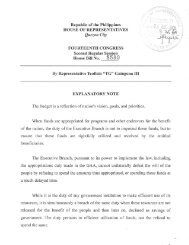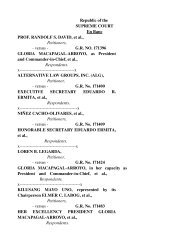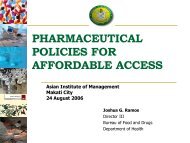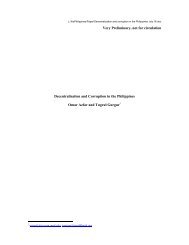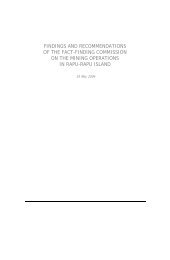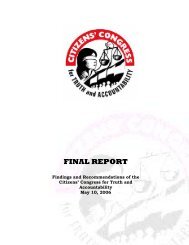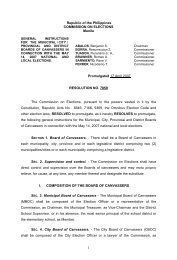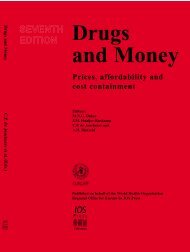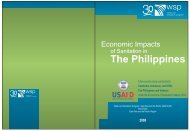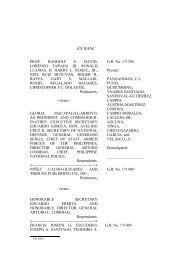The state of water resources in the Philippines - Greenpeace
The state of water resources in the Philippines - Greenpeace
The state of water resources in the Philippines - Greenpeace
You also want an ePaper? Increase the reach of your titles
YUMPU automatically turns print PDFs into web optimized ePapers that Google loves.
C. Ambient <strong>water</strong> quality standards<br />
<strong>The</strong> Clean Water Act def<strong>in</strong>es ambient <strong>water</strong> quality as <strong>the</strong> average <strong>water</strong> purity,<br />
which is dist<strong>in</strong>guished from discharge measurements taken at <strong>the</strong> source <strong>of</strong><br />
pollution. It is <strong>the</strong> general amount <strong>of</strong> pollution present <strong>in</strong> a broad area.<br />
Accord<strong>in</strong>g to EMB, Philipp<strong>in</strong>e <strong>water</strong> quality is assessed based on set beneficial<br />
use as def<strong>in</strong>ed <strong>in</strong> <strong>the</strong> DENR Adm<strong>in</strong>istrative Order (DAO) 34, Series <strong>of</strong> 1990. It<br />
fur<strong>the</strong>r mentions that DAO 34 conta<strong>in</strong>s 33 parameters that def<strong>in</strong>e <strong>the</strong> desired<br />
<strong>water</strong> quality per <strong>water</strong> body classification.<br />
For purposes <strong>of</strong> classification or reclassification, <strong>the</strong> follow<strong>in</strong>g m<strong>in</strong>imum <strong>water</strong><br />
quality parameters are <strong>of</strong>ten used:<br />
• Dissolved Oxygen (DO)<br />
• pH<br />
• Biochemical Oxygen Demand (BOD)<br />
• Total Coliform organisms<br />
<strong>The</strong>se parameters appear to be applicable only for classification or<br />
reclassification <strong>of</strong> surface <strong>water</strong>s (i.e. rivers, lakes, reservoirs) and do not apply<br />
to ground<strong>water</strong> <strong>resources</strong>. Instead, <strong>the</strong> Philipp<strong>in</strong>e National Standards for<br />
Dr<strong>in</strong>k<strong>in</strong>g Water or PNSDW is used as <strong>the</strong> standard for assess<strong>in</strong>g <strong>the</strong> quality <strong>of</strong><br />
ground<strong>water</strong> <strong>resources</strong> (EMB, 2006).<br />
<strong>The</strong> PNSDW <strong>of</strong> 1993 outl<strong>in</strong>es various parameters to be used <strong>in</strong> <strong>the</strong> analysis <strong>of</strong><br />
dr<strong>in</strong>k<strong>in</strong>g <strong>water</strong> quality. <strong>The</strong>re are currently 56 bacteriological, physical, chemical,<br />
radiological, and biological parameters to be monitored (WHO, 2002). However,<br />
<strong>the</strong> relevant parameters used for ground<strong>water</strong> quality assessment are: fecal<br />
coliform, nitrates, and sal<strong>in</strong>ity or chloride content (EMB, 2006).<br />
<strong>The</strong> standard for TDS is 500 mg/L and a “negative” for Coliform. “Negative”<br />
means total coliform must not be detectable <strong>in</strong> any 100 ml sample, while<br />
“positive” means <strong>the</strong> presence <strong>of</strong> total coliform <strong>in</strong> <strong>the</strong> <strong>water</strong> sample (PEM, 2003).<br />
Particular standards for bottled <strong>water</strong> have also been formulated. <strong>The</strong>se<br />
provisions are found <strong>in</strong> <strong>the</strong> Bureau <strong>of</strong> Food and Drugs Adm<strong>in</strong>istrative Order 18-A,<br />
1996 or <strong>the</strong> Standards <strong>of</strong> Quality and Requirements for <strong>the</strong> Process<strong>in</strong>g,<br />
Packag<strong>in</strong>g and Label<strong>in</strong>g <strong>of</strong> Bottled Dr<strong>in</strong>k<strong>in</strong>g Water. This Adm<strong>in</strong>istrative Order<br />
<strong>state</strong>s that particular consideration should be given to <strong>the</strong> follow<strong>in</strong>g potential<br />
pollutants: bacteria, viruses, parasites, fertilizers, pesticides, hydrocarbons,<br />
detergents, phenolic compounds, heavy metals, radioactive substances, and<br />
o<strong>the</strong>r soluble organic and <strong>in</strong>organic substances. It <strong>in</strong>cludes rules and regulations<br />
that cover not only <strong>the</strong> quality <strong>of</strong> <strong>the</strong> product itself, but <strong>in</strong>cludes provisions<br />
address<strong>in</strong>g <strong>the</strong> quality <strong>of</strong> source, production processes and facilities, <strong>in</strong>clud<strong>in</strong>g<br />
handl<strong>in</strong>g and use <strong>of</strong> particular labels.<br />
GREENPEACE | <strong>The</strong> <strong>state</strong> <strong>of</strong> <strong>water</strong> <strong>in</strong> <strong>the</strong> Philipp<strong>in</strong>es 35



